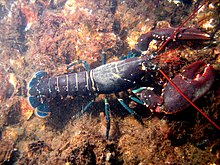Homarus gammarus
| Homarus gammarus | |
|---|---|
 |
|
| Scientific classification | |
| Kingdom: | Animalia |
| Phylum: | Arthropoda |
| Subphylum: | Crustacea |
| Class: | Malacostraca |
| Order: | Decapoda |
| Family: | Nephropidae |
| Genus: | Homarus |
| Species: | H. gammarus |
| Binomial name | |
|
Homarus gammarus (Linnaeus, 1758) |
|
| Synonyms | |
|
|
| External identifiers for Homarus gammarus | |
|---|---|
| Encyclopedia of Life | 1039672 |
| ITIS | 97315 |
| NCBI | 6707 |
| WoRMS | 107253 |
| Also found in: , ARKive, MarLIN | |
Homarus gammarus, known as the European lobster or common lobster, is a species of clawed lobster from the eastern Atlantic Ocean, Mediterranean Sea and parts of the Black Sea. It is closely related to the American lobster, H. americanus. It may grow to a length of 60 cm (24 in) and a mass of 6 kilograms (13 lb), and bears a conspicuous pair of claws. In life, the lobsters are blue, only becoming "lobster red" on cooking. Mating occurs in the summer, producing eggs which are carried by the females for up to a year before hatching into planktonic larvae. Homarus gammarus is a highly esteemed food, and is widely caught using lobster pots, mostly around the British Isles.
Homarus gammarus is a large crustacean, with a body length up to 60 centimetres (24 in) and weighing up to 5–6 kilograms (11–13 lb), although the lobsters caught in lobster pots are usually 23–38 cm (9–15 in) long and weigh 0.7–2.2 kg (1.5–4.9 lb). Like other crustaceans, lobsters have a hard exoskeleton which they must shed in order to grow, in a process called ecdysis (moulting). This may occur several times a year for young lobsters, but decreases to once every 1–2 years for larger animals.
The first pair of pereiopods is armed with a large, asymmetrical pair of claws. The larger one is the "crusher", and has rounded nodules used for crushing prey; the other is the "cutter", which has sharp inner edges, and is used for holding or tearing the prey. Usually, the left claw is the crusher, and the right is the cutter.
The exoskeleton is generally blue above, with spots that coalesce, and yellow below. The red colour associated with lobsters only appears after cooking. This occurs because, in life, the red pigment astaxanthin is bound to a protein complex, but the complex is broken up by the heat of cooking, releasing the red pigment.
...
Wikipedia

